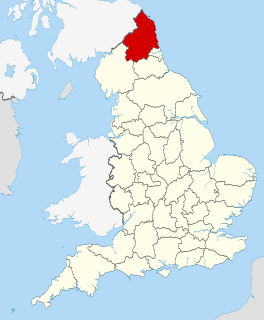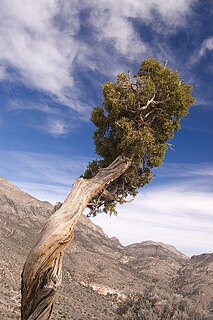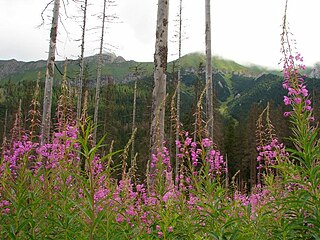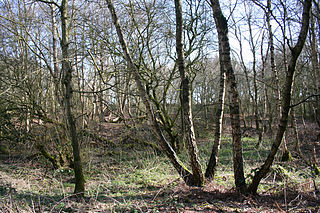| Muggleswick, Stanhope and Edmundbyers Commons and Blanchland Moor | |
| Site of Special Scientific Interest | |
| Country | England |
|---|---|
| Region | North East |
| District | Derwentside Wear Valley Tynedale |
| Location | NY990450 NY950520 |
| - coordinates | 54°49′N2°0′W / 54.817°N 2.000°W Coordinates: 54°49′N2°0′W / 54.817°N 2.000°W |
| Area | 9,118.12 ha (22,531 acres) |
| Notification | 1997 |
| Management | Natural England |
| Area of Search | County Durham |
| Interest | Biological |
| Website: Map of site | |
Muggleswick, Stanhope and Edmundbyers Commons and Blanchland Moor is a Site of Special Scientific Interest in County Durham and Northumberland, England. It consists of two separate areas, the larger—encompassing the upland areas of Muggleswick, Stanhope and Edmundbyers Commons—in the Derwentside and Wear Valley districts of north Durham, the smaller—Blanchland Moor—in the Tynedale district of south-west Northumberland. [1]

A Site of Special Scientific Interest (SSSI) in Great Britain or an Area of Special Scientific Interest (ASSI) in the Isle of Man and Northern Ireland is a conservation designation denoting a protected area in the United Kingdom and Isle of Man. SSSI/ASSIs are the basic building block of site-based nature conservation legislation and most other legal nature/geological conservation designations in the United Kingdom are based upon them, including national nature reserves, Ramsar sites, Special Protection Areas, and Special Areas of Conservation. The acronym "SSSI" is often pronounced "triple-S I".

County Durham is a county in North East England. The county town is Durham, a cathedral city. The largest settlement is Darlington, closely followed by Hartlepool and Stockton-on-Tees. It borders Tyne and Wear to the north east, Northumberland to the north, Cumbria to the west and North Yorkshire to the south. The county's historic boundaries stretch between the rivers Tyne and Tees, thus including places such as Gateshead, Jarrow, South Shields and Sunderland.

Northumberland is a county in North East England. The northernmost county of England, it borders Cumbria to the west, County Durham and Tyne and Wear to the south and the Scottish Borders to the north. To the east is the North Sea coastline with a 64 miles (103 km) path. The county town is Alnwick, although the County council is based in Morpeth.
The site has one of the most extensive areas of dry heath in northern England. There are also areas of wet heath, acid grassland, flushes, relict juniper woodland and small areas of open water.

Grasslands are areas where the vegetation is dominated by grasses (Poaceae); however, sedge (Cyperaceae) and rush (Juncaceae) families can also be found along with variable proportions of legumes, like clover, and other herbs. Grasslands occur naturally on all continents except Antarctica. Grasslands are found in most ecoregions of the Earth. For example, there are five terrestrial ecoregion classifications (subdivisions) of the temperate grasslands, savannas, and shrublands biome (ecosystem), which is one of eight terrestrial ecozones of the Earth's surface.

Junipers are coniferous plants in the genus Juniperus of the cypress family Cupressaceae. Depending on taxonomic viewpoint, between 50 and 67 species of junipers are widely distributed throughout the Northern Hemisphere, from the Arctic, south to tropical Africa, from Ziarat, Pakistan, east to eastern Tibet in the Old World, and in the mountains of Central America. The highest-known juniper forest occurs at an altitude of 16,000 ft (4,900 m) in southeastern Tibet and the northern Himalayas, creating one of the highest tree-lines on earth.

A woodland or wood is a low-density forest forming open habitats with plenty of sunlight and limited shade. Woodlands may support an understory of shrubs and herbaceous plants including grasses. Woodland may form a transition to shrubland under drier conditions or during early stages of primary or secondary succession. Higher density areas of trees with a largely closed canopy that provides extensive and nearly continuous shade are referred to as forests.
The dry heath is dominated by heather, Calluna vulgaris , and wavy hair-grass, Deschampsia flexuosa ; the regionally rare bearberry, Arctostaphylos uva-ursi, is found on the higher parts of Blanchland Moor. Other noteworthy plants are the nationally scarce pale forget-me-not, Myosotis stolonifera , and the regionally rare round-leaved crowfoot, Ranunculus omiophyllus , and ivy-leaved bellflower, Wahlenbergia hederacea , all of which occur in the vicinity of streams, and the nationally scarce spring sandwort, Minuartia verna , one of a number of metallophytes that occur on old spoil heaps around disused lead-mines on Stanhope Common. [1]

Deschampsia flexuosa, commonly known as wavy hair-grass, is a species of bunchgrass in the grass family widely distributed in Eurasia, Africa, South America, and North America.

Arctostaphylos uva-ursi is a plant species of the genus Arctostaphylos (manzanita). Its common names include kinnikinnick and pinemat manzanita, and it is one of several related species referred to as bearberry.
As with the rest of the North Pennines moorlands, of which these areas form part, the site is home to nationally important breeding populations of a number of birds. Three species— merlin, Eurasian golden plover and short-eared owl —are listed in Annex 1 of the European Commission's Birds Directive as requiring special protection; the high density of merlin is particularly noteworthy. Other breeding species include red grouse, Eurasian curlew, common redshank, common snipe and dunlin, which are listed in the United Kingdom's Red Data Book (Birds). [1] [2]

The North Pennines is the northernmost section of the Pennine range of hills which runs north–south through northern England. It lies between Carlisle to the west and Darlington to the east. It is bounded to the north by the Tyne Valley and to the south by the Stainmore Gap.

The merlin is a small species of falcon from the Northern Hemisphere, with numerous subspecies throughout North America and Eurasia. A bird of prey once known colloquially as a pigeon hawk in North America, the merlin breeds in the northern Holarctic; some migrate to subtropical and northern tropical regions in winter. Males typically have wingspans of 53–58 centimetres (21–23 in), with females being slightly larger. They are swift fliers and skilled hunters who specialize in preying on small birds in the size range of sparrows to quail. The merlin has for centuries been well regarded as a falconry bird. In recent decades merlin populations in North America have been significantly increasing, with some merlins becoming so well adapted to city life that they forgo migration.

The short-eared owl is a species of typical owl. Owls belonging to genus Asio are known as the eared owls, as they have tufts of feathers resembling mammalian ears. These "ear" tufts may or may not be visible. Asio flammeus will display its tufts when in a defensive pose, although its very short tufts are usually not visible. The short-eared owl is found in open country and grasslands. The scientific name is from Latin. The genus name Asio is a type of eared owl, and flammeus means "flame-coloured".














